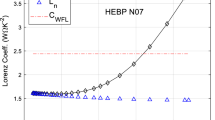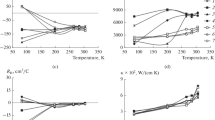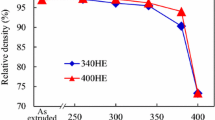Abstract
Hot extruded bulk polycrystalline n-type (Bi1-xSbx)2(Te1-ySey)3 quaternary alloys with low Sb and Se concentrations (< 10%) are anisotropic materials by virtue of their texture which is a result of severe shearing involved in the extrusion process. Harman-type measurements have provided the electrical and thermal conductivity, Seebeck coefficient, and thermoelectric figure of merit parallel to the extrusion axis, as a function of temperature, in the range ~ 220–420 K. Mobility and carrier concentration were determined by Hall effect measurements along a plane perpendicular to the extrusion axis in the range 15–420 K. Modeling the electronic transport properties allows the determination of the total (including thermodiffusion) electronic contribution to the thermal conductivity. Thus, the lattice thermal conductivity \(\kappa_{\parallel }^{{}}\), along the extrusion axis, can be obtained with a reasonable degree of accuracy in the range 220–380 K. The results carry a rather large relative uncertainty at higher temperatures as \(\kappa_{\parallel }^{{}}\) decreases with increasing temperature with a tendency which mimics that observed for the crystalline base compound Bi2Te3.




Similar content being viewed by others
References
R. Venkatasubramanian, E. Sivola, T. Colpitts, and B. O’Quinn, Thin-flm thermoelectric devices with high room-temperature figures of merit. Nature 413, 597–602 (2001).
T.C. Harman, P.J. Taylor, M.P. Walsh, and B.E. LaForge, Quantum dot superlattice thermoelectric materials and devices. Science 297, 2229–2232 (2002).
D. Li, Wu. Yiying, P. Kim, Li. Shi, P. Yang, and A. Majumdar, Thermal conductivity of individual silicon nanowires. Appl. Phys. Lett. 83, 2934–2936 (2003).
W. Kim, J. Zide, A. Gossard, D. Klenov, S. Stemmer, A. Shakouri, and A. Majumdar, Thermal conductivity reduction and thermoelectric figure of merit increase by embedding nanoparticles in crystalline semiconductors. Phys. Rev. Lett. 96, 045901–045904 (2006).
M.S. Dresselhaus, G. Chen, M.Y. Tang, R. Yang, H. Lee, D. Wang, Z. Ren, J.-P. Fleurial, and P. Gogna, New directions for low-dimensional thermoelectric materials. Adv. Mater. 19, 1043–53 (2007).
B. Poudel, Q. Hao, Y. Ma et al., High-thermoelectric performance of nanostructured bismuth antimony telluride bulk alloys. Science 320, 634–638 (2008).
D. Vasilevskiy, M.S. Dawood, J.-P. Masse, S. Turenne, and R.A. Masut, Generation of nanosized particles during mechanical alloying and their evolution through the hot extrusion process in bismuth telluride based alloys. J. Electron. Mat. 39, 1890–1896 (2010).
C. Dames and G. Chen, Thermal conductivity of nanostructured thermoelectric materials, in Thermoelectrics Handbook: Macro to Nano, 42, 1–16, D.M. Rowe Editor (Taylor & Francis, Boca Raton USA) (2006).
D. Narducci, Do we really need high thermoelectric figures of merit? A critical appraisal to the power conversion efficiency of thermoelectric materials. Appl. Phys Lett. 99, 102104 (2011). https://doi.org/10.1063/1.3634018.
J.K. Lee, S. Park, B. Ryu, H.S. Lee, J. Park, and S. Park, Effect of defect interactions with interstitial Ag in the lattice of Bi2xSb2-xTe3 alloys and their thermoelectric properties. Appl. Phys. Lett. 118, 052102 (2021).
F. Shi, H. Wang, Q. Zhang, X. Tan, Y. Yin, Hu. Haoyang, Z. Li, J.G. Noudem, G. Liu, and J. Jiang, Improved thermoelectric properties of BiSbTe-AgBiSe2 alloys by suppressing bipolar excitation. ACS Appl. Energy Matter. 4, 2944–2950 (2021).
H.-L. Zhuang, J. Pei, B. Cai, J. Dong, H. Haihua, F.-H. Sun, Y. Pan, G. Jeffrey Suyder, and J.-F. Li, Thermoelectric performance enhancement in bisbte alloy by microstructure modulation via cyclic spark plasma sintering with liquid phase. Adv. Funct. Mat. 31, 2009681 (2021).
D. Vasilevskiy, J.-M. Simard, F. Bélanger, F. Bernier, S. Turenne et J. L’Ecuyer, Texture formation in extruded rods of (Bi,Sb)2(Te,Se)3 thermoelectric alloys, proceedings of the 21st international conference on thermoelectrics, ICT’02, Long Beach, California, USA, 25–29 August, IEEE, p 24–27. DOI: https://doi.org/10.1109/ICT.2002.1190257 (2003)
J.M. Simard, D. Vasilevskiy, S. Turenne, Influence of composition and texture on the thermoelectric and mechanical properties of extruded (Bi1-xSbx)2(Te1-ySey)3 alloys, twenty-second international conference on thermoelectrics, IEEE proceedings ICT’03, 13–18, (2003).
M.K. Keshavarz, D. Vasilevskiy, R.A. Masut, and S. Turenne, Mechanical properties of bismuth telluride based alloys with embedded MoS2 nano-particles. Mat. and Design 103, 114–121 (2016).
R.A. Masut, D. Vasilevskiy, and M.K. Keshavarz, Elastic modulus and internal friction of thermoelectric composites: enthalpy-entropy compensation. J. Appl. Phys. 129, 245106–245111 (2021).
R.A. Masut, C. André, D. Vasilevskiy, and S. Turenne, Charge transport anisotropy in hot extruded bismuth telluride: scattering by acoustic phonons. J. Appl. Phys. 128, 115106–115111 (2020).
C. Andre, D. Vasilevskiy, S. Turenne, and R.A. Masut, Extruded bismuth-telluride-based n-Type alloys for waste heat thermoelectric recovery applications. J. Electron. Mat. 38, 1061–1067 (2009).
G.S. Nolas, J. Sharp, and H.J. Goldsmid, Thermoelectrics Basic Principles and New Materials Developments, (Berlin: Springer, 2001).
H.J. Goldsmid, A.R. Sheard, and D.A. Wright, The performance of bismuth telluride thermojunctions. Britt. J. Appl. Phys. 9, 365–370 (1958).
O. Ben-Yehuda, R. Shuker, Y. Gelbstein, Z. Dashevsky, and M.P. Dariel, Highly textured Bi2Te3-based materials for thermoelectric energy conversion. J. Appl. Phys. 101, 113707 (2007).
H. Kaibe, Y. Tanaka, M. Sakata, and I. Nishida, Anisotropic galvanomagnetic and thermoelectric properties of n-type single crystal with the composition of a useful thermoelectric cooling material. J. Phys. Chem. Solids 30, 945–950 (1989).
W. Zawadski, R. Kowalczyk, and J. Kolodziejczak, The generalized fermi-dirac integrals. Phys. Stat. Sol. 10, 513–518 (1965).
H.-S. Kim, Z.M. Gibbs, Y. Tang, H. Wang, and G. Jeffrey, Snyder, characterization of lorenz number with seebeck coefficient measurement. APL Mat. 3, 041506 (2015).
D. Palaporn, W. Mongkolthanaruk, S.-a Tanusilp, K. Kurosaki, and S. Pinitsoontorn, A simple method for fabricating flexible thermoelectric nanocomposites based on bacterial cellulose nanofiber and Ag2Se. Appl. Phys. Lett. 120, 073901 (2022).
S.-F. Wang, Z.-G. Zhang, B.-T. Wang, and J.-R. Zhang, and F.-W. Wang, Intrinsic ultralow lattice thermal conductivity in the full-heusler compound Ba2AgSb. Phys. Rev. Appl. 17, 034023 (2022).
H.J. Goldsmid, The thermal conductivity of bismuth telluride. Proc. Phys. Soc., London Sect. B 69, 203–209 (1956).
C.B. Satterthwaite and R.W. Ure Jr., Electrical and thermal properties of Bi2Te3. Phys. Rev. 108, 1164–1170 (1957).
J.-M. Simard, D. Vasilevskiy, F. Belanger, J. L’Ecuyer and, S. Turenne, Production of thermoelectric materials by mechanical alloying - extrusion process, proceedings ICT2001. 20 international conference on thermoelectrics (Cat. No.01TH8589), 08–11 June 2001, Beijing, China, IEEE, p 132–135. DOI: https://doi.org/10.1109/ICT.2001.979840 (2002).
Y. Zhu, Y. Xia, Y. Wang, Y. Sheng, J. Yang, F. Chenguang, A. Li, T. Zhu, J. Luo, G. Christopher Wolverton, J. Snyder, J. Liu, and W. Zhang, Violation of the T−1 relationship in the lattice thermal conductivity of Mg3Sb2 with locally asymmetric vibrations. AAAS Res. 2020, 4589786 (2020).
B.-L. Huang and M. Kaviany, Ab initio and molecular dynamics predictions for electron and phonon transport in bismuth telluride. Phys. Rev. B 77, 125209 (2008).
R.A. Masut, Role of deep defects on the transport properties of polycrystalline thermoelectric alloys and composites. J. Electron. Mat. 51, 4816–4823 (2022).
Acknowledgments
We acknowledge the financial assistance of the Natural Sciences and Engineering Research Council of Canada (NSERC) for support through the Discovery Grants program, grant RGPIN-2016-06417. We acknowledge as well the support of the Fonds de recherche du Québec–Nature et technologies (FRQNT).
Author information
Authors and Affiliations
Corresponding author
Ethics declarations
Conflict of interest
The authors declare that they have no conflict of interest.
Additional information
Publisher's Note
Springer Nature remains neutral with regard to jurisdictional claims in published maps and institutional affiliations.
Appendices
Appendix A
Review of the Electron Transport Model of HEBP Alloys
The transport model applicable at low applied electric fields and temperature gradients recognizes the importance of obtaining the most accurate description possible of the near equilibrium charge carrier chemical potential \(\zeta\) relative to one of the band edges as a function of temperature. In the case of n-type semiconductors, the quantity \(\Delta_{c} \equiv \zeta - E_{c0}\) is introduced, where \(E_{c0}\) is the conduction band edge at the minima points \({\varvec{K}}_{{0i_{c} }}\) (\(i_{c} = 1,2...N_{{V_{c} }}\)) in K-space, where \(N_{{V_{c} }}\) is the number of valleys in the conduction band. The quantity \(\Delta_{c} \left( T \right)\) is obtained as a function of temperature by solving the neutrality equation including electron ionized deep traps:
The residual carrier concentration \(N_{res} = N_{d}^{sh} - N_{a}^{{}}\) is a constant controlled only by shallow donor doping of concentration \(N_{d}^{sh}\) and possible acceptor impurities. The approximation of fully ionized shallow donors and of (all) acceptors in Eq. (A-1) restricts the validity of the approach to a limited temperature range where they are fully ionized, so this approximation cannot hold for very low temperatures (< 10 K).
\(N_{D}^{ + }\) represents the ionized density of deep donors with energy levels \(E_{D} = E_{c0} - \varepsilon_{D}\) deep within the gap, whose total concentration is \(N_{DD}^{{}}\), or \(N_{D}^{ + } = f_{DD}^{( + )} N_{DD}^{{}} = \left( {1 + 2\exp \left( {\frac{{\Delta_{c} + \varepsilon_{D} }}{{k_{B} T}}} \right)} \right)^{ - 1} N_{DD}\).
The solution of the neutrality equation (A-1), found in semiconductor physics, can be obtained using any computational tool providing a routine to numerically find the roots of a non-linear function of one variable, such as the “fzero” script in MATLAB.
The dispersion relation near the band edges is written as:
where \(E_{c} \left( {\user2{x,K}_{{0i_{c} }} } \right) = E_{c0} - \left| e \right|\psi \left( {\varvec{x}} \right)\) and \(\psi \left( {\varvec{x}} \right)\) is the electric potential. This model is based on the assumption that for quaternary alloys whose composition is close to the base compound Bi2Te3 (small concentrations of Sb2Te3 and Bi2Se3) \(\varepsilon \left( {\varvec{k}} \right)\) can be approximated by the non-parabolic form17:
The parameter \(\lambda \left( T \right)\) is in general a function of the absolute temperature T and is taken as the inverse of the energy gap \(E_{g} \left( T \right) = \Delta_{g0} - c_{T} T\) of the material, which has a constant temperature coefficient \(c_{T}\). A corresponding expression is proposed for the dispersion relation of holes in the valence band. These assumptions are expected to apply for an energy range within 0.1 eV of the band edges and are based on an approximation of the DOS provided by ab initio calculations of the base compound,31 which is expressed as:
where \(\Theta \left( \varepsilon \right)\) is the unit step function.
A second important assumption concerns the anisotropy of HEBP alloys and proposes and anisotropic one-particle distribution function as a solution of the Boltzmann transport equation in the form of a diagonal matrix with two equal components describing transport in the plan perpendicular to the extrusion axis \(g_{ \bot ex} \left( {\user2{x,K}} \right) = g_{ \bot } \left( {\user2{x,K}} \right)\). The third diagonal element \(g_{\parallel } \left( {\user2{x,K}} \right)\) corresponds to transport along the extrusion axis. The properties of interest are calculated using \(g_{ \bot } \left( {\user2{x,K}} \right)\), since there is empirical evidence that motion along the extrusion axis differs from perpendicular transport by a constant factor. As will be shown, for the quaternaries of interest here this constant factor applies to the temperature range ~ 220–400 K, where only one scattering mechanism prevails, and in this range \(g_{\parallel } \left( {\user2{x,K}} \right) \approx f_{an} g_{ \bot } \left( {\user2{x,K}} \right)\). For more specific details of the model, please see Section 2 of Masut et al.17
Once \(\Delta_{c} \left( T \right)\) has been obtained, then the full distribution function \(g_{ \bot } \left( {\user2{x,K}} \right) = f + g_{ \bot }^{\left( 1 \right)} \left( {\user2{x,K}} \right)\) can be determined. In addition to f, the Fermi–Dirac equilibrium distribution function, it involves the first-order term \(g_{ \bot }^{\left( 1 \right)} \left( {\user2{x,K}} \right)\) which is the solution of the Boltzmann transport equation in the relaxation time approximation. Its expression \(g_{ \bot }^{\left( 1 \right)} \left( {\varvec{K}} \right) = - \tau_{ \bot } \left( { - \frac{\partial f}{{\partial \varepsilon }}} \right)\left( {\nabla F + \frac{{\varepsilon \left( {\varvec{k}} \right) - \Delta_{c} }}{T}\nabla T} \right)_{ \bot } \cdot {\varvec{\upsilon}}_{ \bot }\) involves the gradients of the absolute temperature and of the electrochemical potential F, the velocity operator \({\varvec{\upsilon}}_{ \bot }\) and the corresponding relaxation time \(\tau_{ \bot }\). The expression for the transport properties can be obtained from calculations of the flow densities \({\varvec{X}}\) (of electric charge, heat and energy) in the plane perpendicular to the extrusion direction which are expressed by a scalar quantity,
In the limit \(V \to \infty\) these integrals are replaced by integrals on energy using the DOS expression (Eq. (A-4));\(s\) denotes in principle other possible degrees of freedom, and here only spin degeneracy is considered.
The measured mobility is not predicted (nor experimentally observed) to be thermally activated, which means that grain boundary effects on the transport properties of these alloys can be ignored.32 This is simply a consequence of the high scattering rates due to impurities in the heavily doped samples of use for thermoelectric applications. Then the charge carriers mean free path (in the submicron scale) is much smaller than the average grain size (larger than a few micrometers).32
As can be seeing by examining the data, intraband carrier scattering caused by absorption or emission of acoustic phonons is usually the limiting mechanism determining carrier mobility near room temperature. Hall effect data at lower temperatures will be considered, where other scattering mechanisms may play a limiting role. The expression for the scattering rate due to acoustic phonons \({1 \mathord{\left/ {\vphantom {1 {\tau_{ \bot }^{ac} }}} \right. \kern-\nulldelimiterspace} {\tau_{ \bot }^{ac} }}\) within the non-parabolic approximation has been derived in Masut et al.17:
while the rate for ionized impurity scattering is given by32:
The physical properties in the plain perpendicular to the extrusion axis, such as the mobility, are calculated using the flows of Eq. (A-5) which involve integrals of the form \(\int_{BZ} {\frac{{d^{3} K}}{{4\pi^{3} }}\tau_{ \bot } \left( {E_{c} - C} \right)^{\ell } \left( { - \frac{\partial f}{{\partial \varepsilon }}} \right)} {\varvec{\upsilon}}_{ \bot } {\varvec{\upsilon}}_{ \bot } ; \, \ell = 0,1,2...\) (C is independent of \(\varepsilon\)) multiplying the driving forces \(\left( {\nabla F,\nabla T} \right)\). The transport coefficient will then be proportional to these integrals which can be expressed as triple-index generalized Fermi–Dirac (GFD) integrals, introduced many years ago by the work of Zawadsky et al.23, of the form
where \(\eta\) for electrons (holes) is \(\eta_{c} \equiv {{\Delta_{c} } \mathord{\left/ {\vphantom {{\Delta_{c} } {k_{B} T}}} \right. \kern-\nulldelimiterspace} {k_{B} T}} \equiv {{\left( {\zeta - E_{c0} } \right)} \mathord{\left/ {\vphantom {{\left( {\zeta - E_{c0} } \right)} {k_{B} T}}} \right. \kern-\nulldelimiterspace} {k_{B} T}}\) (\(\eta_{v} \equiv {{\Delta_{v} } \mathord{\left/ {\vphantom {{\Delta_{v} } {k_{B} T}}} \right. \kern-\nulldelimiterspace} {k_{B} T}}\)), \(\beta \equiv {{k_{B} T} \mathord{\left/ {\vphantom {{k_{B} T} {E_{g} }}} \right. \kern-\nulldelimiterspace} {E_{g} }}\), and \(E_{g} \left( T \right)\) is the temperature-dependent energy gap of the semiconductor. These integrals are easy to evaluate numerically, since they contain the derivative of the equilibrium Fermi–Dirac function \(\left( { - \frac{\partial f}{{\partial z}}} \right)\) which is symmetrically centered at the value \(z = \eta_{c/v}\), and of narrow width for degenerate semiconductors. The expressions for the electron and hole mobilities, the electrical conductivity and the Seebeck coefficient have been given in this article and in previous publications.17,32 Those for the Lorenz coefficient are given in this article (see "Extraction of Thermal Conductivity" section).
Rights and permissions
Springer Nature or its licensor (e.g. a society or other partner) holds exclusive rights to this article under a publishing agreement with the author(s) or other rightsholder(s); author self-archiving of the accepted manuscript version of this article is solely governed by the terms of such publishing agreement and applicable law.
About this article
Cite this article
Masut, R.A., André, C. & Vasilevskiy, D. Hot Extruded Bulk Polycrystalline (Bi1-xSbx)2(Te1-ySey)3 Alloys: Electron Transport and Lattice Thermal Conductivity. J. Electron. Mater. 52, 707–717 (2023). https://doi.org/10.1007/s11664-022-10041-x
Received:
Accepted:
Published:
Issue Date:
DOI: https://doi.org/10.1007/s11664-022-10041-x




